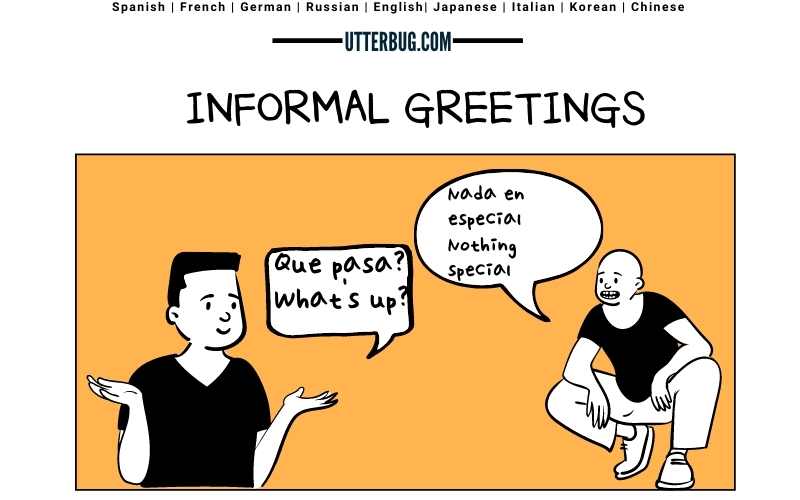
To get you off on the right introduction, you need to know how to say Hello, Hi, Hola, top Spanish Greetings to people properly. Just as in English language, there are several expressions that can be used of saying wishes in Spanish. You can simply use Spanish versions of ‘Hello’ i.e 'Hola' on its own.
For Good Morning, You can also use Buenos Días and for Good Afternoon or Good Evening as casual Greetings, use Buenas Tardes, and buenas noches (good evening – once it’s dark). A native Spanish speakers would use these greetings usually together especially Hola, buenos días and hola, buenas tardes. We have done in depth lesson about formal introductions in Banks, or shops while handing money or financial transactions.

| Spanish | English | Where to Use? |
| Hola. | Hello. | Casual/Informal |
| ¡Hola, Jaime! | Hi Jaime! | Casual/Informal |
| Buenos días | Good morning | Formal |
| Hola, buenos días | Good morning | Formal |
| Buenas tardes, Luis | Good afternoon, Luis | Formal |
| Buenas noches | Good evening | Formal |
| Muy buenas | Very Good | Informal |

You’ll also want to ask the people you know how they are. The simplest way to do this is by using ¿Qué tal? This is quite informal, and suitable when you know the person quite well. If you want to be more formal you say ¿Cómo está? to someone you speak to as usted. Read details of Time related phrases can also be used ex What is the time in Spanish.
| Hola, Juana, ¿qué tal? | Hi, how are you, Juana? |
| ¡Buenos días! ¿Cómo está, señor García? | Good morning! How are you, señor García? |
| Hola, Pepe, ¿qué tal te va? | Hello, Pepe, how’s it going? |
| ¿Qué pasa, Raquel? ¡Cuánto tiempo sin verte! | How are things, Raquel? It’s ages since I’ve seen you! |
| Hola, Juana, ¿qué tal? | Hi, how are you, Juana? |
| ¡Buenos días! ¿Cómo está, señor García? | Good morning! How are you, señor García? |
| Hola, Pepe, ¿qué tal te va? | Hello, Pepe, how’s it going? |
| ¿Qué pasa, Raquel? ¡Cuánto tiempo sin verte! | How are things, Raquel? It’s ages since I’ve seen you! |

| Spanish | English | Pronunciation |
| Que pasa? | What's up? | keh pah-sah |
| Como van las cosas? | How are things? | koh-moh bahn lahs koh-sahs |
| Como estas? | How are you? | koh-moh ehs-tahs |
| Como has estado? | How have you been? | koh-moh ahs ehs-tah-do |
| Como te va? | How's it going? | koh-moh tay vah |
| Como te ha ido? | How's it been going? | koh-moh tay ah ee-doh |
| Como vas? | How are you doing? | koh-moh vahs |
| Que hay da nuevo? | What's new? | keh aheeh day new-way-voh |


| Spanish | English | Pronunciation |
| Como esta usted? | How are you? | koh-moh ehs-tah oos-tedh |
| Como ha ested? | How have you been? | koh-moh ah ehs-tah-do |
| Como le va? | How's it going? | koh-moh lay vah |
| Como le ha ido? | How's it been going? | koh-moh lay ah ee-doh |
| Que tal se encuentra usted? | How are you? | keh tahl say ehn-kwehn-trah-oos-tehd |

LO SABÍAS? When you are being introduced to someone, you will want to know how to respond. The traditional Greetings should rather be used in formal or business meetings these days, and very often people say
Hola! Qué tal? For which, You would reply in the – Hola! Qué tal?.
| Me llamo Daniel Norrington. | My name is Daniel Norrington. |
| Me llamo Liz Owen. | My name is Liz Owen. |

LO SABÍAS? Buenas noches in Spanish means ‘Good Evening’ or 'Good Night'. So you use it both when arriving and leaving somewhere in the evening. When saying goodbye to someone you know you’ll see tomorrow, such as a colleague, you would say Hasta Mañana, meaning see you tomorrow in English. Please review some examples below.
| Hasta luego! | See you! |
| Hasta pronto! | See you soon! |
| Hasta mañana! | See you tomorrow! |
| Hasta el lunes! | See you on Monday! |


Use adiós or 'Good Bye' in English, or Hasta Pronto meaning 'See you soon' to say goodbye to people in casual way and people who are not close to you. You can also just say hasta luego or See You, if you want to sound more informal in Spanish.
| Adiós! | Goodbye! |
| Adiós! Hasta otra! | Goodbye! See you again! |
| ¡Buenas noches! | Good night! |


Saying No can be difficult, especially in a secondary language. Below are standard Negations used to